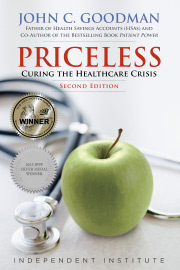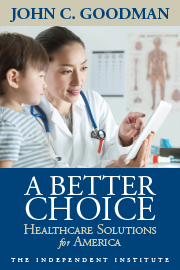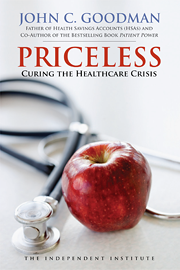In economics, the word “waste” has a very precise meaning. It’s not in the eyes of the beholder. Instead, waste exists if there is a change that in principle could make everyone better off.
Here is why that matters.
On the one hand, Elon Musk has been given a goal of reducing government waste by the Trump administration. On the other hand, congressional Republicans are desperate to find ways to cut spending in order to pay for a high-priority tax bill. The intersection of these two goals creates a rare opportunity to institute reforms that would be very hard to accomplish under ordinary circumstances.
So far, Congress has ignored Musk’s Department of Government Efficiency (DOGE). The latest list of possible spending cuts from the House Budget Committee are sure to be unpopular. They take funds from such programs as Medicaid and food stamps and thus offer fodder to critics who claim the Republicans are cutting taxes for the rich on the backs of the poor. They also do very little to eliminate actual waste.
As I showed in Part I and Part II of this series, the federal government’s entitlement spending programs are replete with inefficiencies. By eliminating wasteful practices, we can in principle make trillions of dollars available for tax reform and make entitlement programs work better for the beneficiaries at the same time.
Here are a few more examples.
Medicare abroad. There are a very large number of Americans living as ex patriots in other countries. By one estimate, they number between 4.4 and 5.5 million. It looks as though there are a dozen countries with more than 10,000 Americans in residence.
Living abroad turns out to be especially attractive to senior retirees. One reason: meeting essential needs is often much less expensive, including housing, maid services, assisted living, etc. Another reason is to retire near family members.
Under current law, however, if the senior needs medical care, our Medicare system doesn’t pay. Consider a retiree living in Panama, who discovers he needs bypass heart surgery. Even though Panama has many excellent doctors and many first-rate hospitals, Medicare will only pay if the retiree returns to this country and has the surgery performed in the U.S.
And that is exactly what happens today because it is cheaper for the beneficiary to use their Medicare coverage in the U.S. rather than paying privately for the surgery locally.
What makes this especially strange is that the individual has paid Medicare taxes his entire work life (and therefore should be entitled to something in return), and the cost of most medical services in Panama is a fraction of what the cost is in this country.
A bill has been introduced in Congress to create a pilot program to fund Medicare Advantage plans in foreign countries. Industry experts believe that if the program were fully implemented, the savings would be about $100 billion a year.
Over ten years, the savings would approach $1 trillion, with a large share of that benefiting U.S. taxpayers.
Reinsurance in the Obamacare exchanges. In any given year in a normal insurance pool, 5 percent of enrollees account for 50 percent of the spending. Insurers understand this and accept that some of their customers are going to be expensive. However, the risk that they might attract an enrollee with really high costs forces insurers to raise the premiums they charge to mainly healthy people.
The highly skewed costs we typically see in health care and the variability of costs for the 5 percent add to the difficulty of pricing insurance for the remaining 95 percent.
A sensible answer is reinsurance, whereby insurers can transfer the risk of unpredictable high costs to a state reinsurance pool in return for a premium. The Affordable Care Act (Obamacare) allows states to receive federal waivers to do this.
This type of reform has already led to lower costs in seven states, where premiums fell by nearly 7.5 percent while rising in the other 44 states (including D.C.) by more than 3 percent. In Maryland in 2018, premiums that had been expected to rise 30 percent actually fell by 13 percent thanks to state reinsurance reform.
One estimate suggests that reinsurance coupled with a few other modest reforms would result in premiums falling by up to 24 percent, nearly 4 million more people buying coverage, and all without spending any new federal taxpayer money.
If every state did this the savings would be roughly $240 billion over ten years—divided between the federal and state governments.
Other reforms in the Obamacare exchanges. In most instances, the insurance sold in the marketplace exchange looks like Medicaid with a high deductible. Most enrollees are paying zero premium, because with the new enhanced subsidies we are virtually giving the insurance away.
However, when people get sick, they face deductibles that are twice what they are in a typical employer plan. The out-of-pocket exposure for an individual is $9,200 and it’s twice that for a family.
To make matters worse, doctors and hospitals that refuse to take Medicaid managed care usually refuse to take Obamacare insurance as well.
So, what’s the answer?
There are only two places in our health care system where there is an annual open enrollment, private plans compete, buyers get government subsidies, and premiums are community rated: the Obamacare exchange and Medicare Advantage. The latter works reasonably well, has attracted more than half of all seniors, and is accepted by almost all providers. The former has all the problems described above.
Even if we didn’t have a DOGE committee and even if we didn’t need funds for tax reform, the case for remaking the exchange to look like Medicare Advantage is extremely strong. And it’s not that hard.
Under the reform, each plan would receive a risk-adjusted premium so that the healthy and the sick would be equally attractive to the insurers. Enrollees would no longer be able to game the system by remaining uninsured while they are healthy. And health plans could specialize in such conditions as diabetes, heart disease and cancer—just as they do in Medicare Advantage today.
As part of the reform, we need to allow insurers to make deposits to what I call a Roth HSA account for all primary care. Money remaining in the account at the end of the insurance period could be withdrawn for non-health care purposes without taxes or penalties.
If these accounts were fully utilized the savings would approach $300 billion over 10 years.
Tax credits for employer-provided insurance. There have been a number of proposals to cap the tax subsidy for employer-provided health insurance. In fact, the original Affordable Care Act had that provision.
However, capping the tax exclusion at the workplace would have only a small impact on spending, and it is unanimously resisted by both business and labor.
Here is a better idea. Give companies an option to remain in the current system or accept a tax credit of, say, $3,000 per employee, per year. As I have explained elsewhere, the tax credit approach has a major impact on choices—allowing employees to convert every dollar reduction in wasteful spending into a dollar of take-home pay.
These employees could also have an employer-funded Roth HSA account.
If this reform cut federal spending on employer-provided health insurance by 10 percent, the savings would be more than $500 billion over ten years.
These are only a few of the ways that reforming our entitlement programs can help fund the tax bill and improve benefits for enrollees at the same time.












